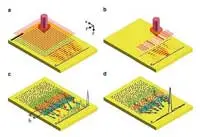 A research group from Korea’s Institute of Basic Science has devised a disordered arrangement for antennas, which is said to minimise redundancy and to enable each antenna to function independently. As a result, the device is said to provide 40 times wider bandwidth than periodically arranged antennas.
A research group from Korea’s Institute of Basic Science has devised a disordered arrangement for antennas, which is said to minimise redundancy and to enable each antenna to function independently. As a result, the device is said to provide 40 times wider bandwidth than periodically arranged antennas.
"We are proposing a new way to connect nanoscale microprocessors to high-speed optical communications," commented Dr Wonjun Choi.
Due to technical limitations, the processing speed of semiconductors has remained at several gigahertz for the past decade. To counter this, many MCUs are used in parallel, but the electrical connection between the processors is slow. To solve this problem, many studies have been conducted to merge processors by using optical signals.
The team used surface plasmons to mediate optoelectronic signalling. At nano antennas, optical signals are converted to surface plasmons, which then propagate through the metal surface as electric signals. The researchers randomly arranged the nano antennas, and the surface plasmons generated at each antenna underwent multiple scattering to minimise redundancy between the antennas.
In this way, each antenna could be used independently, resulting in a substantial increase in the effective number of antennas. This increases the number of multiple input channels in the MIMO communication, which leads to an increase in the information transmission bandwidth.
“We proved that we can transmit signals to six different microprocessors at the same time and proved that optical images are converted into plasmons,” concluded Dr Choi.
Author
Peggy Lee
Source: www.newelectronics.co.uk
